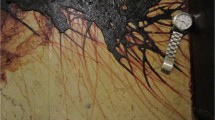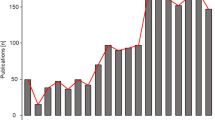Abstract
The process of killing of an elk by wolves (from the first grip to death) was investigated. Applying the methodology developed by the author for locating the grips (bites) according to tufts of elk wool cut or torn out by a predator from the prey’s body, the sequence and frequency of grips on the elk body were determined at different stages of the killing process. The greatest number of grips was inflicted to perineum (42.5%), thigh, shin (29.6%), and neck (16.5%), while the least number of grips was made into the belly (3.5%), head (3.5%), breast (2.6%), side (0.9%), and sacrum (0.9%). It was established that, during a killing, predators tended to immobilize the prey and damage the tendons of hind legs or grip vital places. When wolves grip an elk’s breast or neck, large veins or lungs are broken and an air embolism occurs, which causes the blockage of blood vessels and the rapid death of the prey. When killing prey, a pair of wolves (adult male and female) produces fewer grips but damages the vital points, while a family of wolves (pack) injures different parts of the body, making more grips. The latter is associated with the final stage of training the young individuals in killing the prey. This stage was preceded by a training course in hunting small and mid-sized wild and domestic animals. Young wolves first learn to hunt cattle, mostly calves; only after this do they participate in the hunt for elk. General regularities of the killing characteristics of the whole population, pairs, and packs (families) were established.
Similar content being viewed by others
References
Bologov, V., Okhota Okhotn. Khoz., 1981, no. 3, p. 12.
Korytin, S.A. and Bibikov, D.I., Volk (Wolf), Moscow: Nauka, 1985, p. 311.
Kulagin, N.M., Losi SSSR. Trudy Laboratorii Prikladnoi Zoologii (Elks of the USSR: Collected Papers of the Applied Zoology Laboratory), Leningrad: Akad. Nauk SSSR, 1932.
Lobashev, M.E., Issledovaniya po genetike (Genetic Research), Leningrad: Izd. Leningr. Gos. Univ., 1961, p. 3.
Manteifel’, B.P., Ekologiya povedeniya zhivotnykh (Animal Behavior Ecology), Moscow: Nauka, 1980.
Promptov, A.N., Zh. Eksp. Biol., 1929, vol. 5, no. 3/4, p. 149.
Yazan, Yu.P., Okhota na kopytnykh (Hunting for Ungulates), Moscow: Lesn. Prom., 1976, p. 6.
Allen, D., Natur. Hist., 1979, vol. 88, no. 5, p. 46.
Beschta, R.L. and Ripple, W.J., Ecohydrology, 2008, no. 1, p. 118.
Beschta, R.L. and Ripple, W.J., Biol. Conserv., 2009, vol. 142.
Halofsky, J. and Ripple, W., Forestry, 2008. doi: 10.1093/forestry/cmp044
Halofsky, J.S. and Ripple, W.J., Oecologia, 2008, no. 155, p. 869.
Manning, A.D., Gordon, I.J., and Ripple, W.J., Restoring Landscapes of Fear with Wolves in the Scottish Highlands, Biol. Conserv., 2009. doi: 10.1016/ j.biocon.2009.05.007
Mech, L.D., The Wolf: The Ecology and Behavior of an Endangered Species, New York, 1970.
Scott, J. and Fuller, J., Genetics and Social Behavior of the Dog, Chicago: Univ. Chicago Press, 1965.
Author information
Authors and Affiliations
Corresponding author
Additional information
Original Russian Text © V.V. Kochetkov, 2012, published in Uspekhi Sovremennoi Biologii, 2012, Vol. 132, No. 3, pp. 259–267.
Rights and permissions
About this article
Cite this article
Kochetkov, V.V. Wolf (Canis lupus) and elk (Alces alces): The killing of prey. Biol Bull Rev 2, 479–486 (2012). https://doi.org/10.1134/S2079086412060060
Published:
Issue Date:
DOI: https://doi.org/10.1134/S2079086412060060




